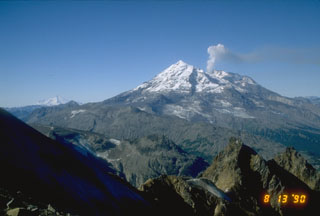Report on Redoubt (United States) — 5 November-11 November 2008
Smithsonian Institution / US Geological Survey
Weekly Volcanic Activity Report, 5 November-11 November 2008
Managing Editor: Sally Sennert.
Please cite this report as:
Global Volcanism Program, 2008. Report on Redoubt (United States) (Sennert, S, ed.). Weekly Volcanic Activity Report, 5 November-11 November 2008. Smithsonian Institution and US Geological Survey.
Redoubt
United States
60.485°N, 152.742°W; summit elev. 3108 m
All times are local (unless otherwise noted)
On 5 November, AVO raised the Aviation Color Code for Redoubt to Yellow and the Volcano Alert Level to Advisory because of significant changes in gas emission and heat output during the previous several months. The changes were a departure from the long-observed background activity. ASTER satellite images from 13 October detected warming near the summit craters; evidence of warming had been directly observed in July 2008. Fumarolic activity and water flowing beneath Drift Glacier on the N flank had produced a 45-m-wide melt or collapse hole at an elevation of about 1,700 m (5,600 ft) on the Drift Glacier. On 2 November, a slushy debris-flow deposit originated from about the location of the 1966-68 vent. During 6-11 November, no activity was observed on satellite imagery and seismicity remained low.
Geological Summary. Redoubt is a glacier-covered stratovolcano with a breached summit crater in Lake Clark National Park about 170 km SW of Anchorage. Next to Mount Spurr, Redoubt has been the most active Holocene volcano in the upper Cook Inlet. The volcano was constructed beginning about 890,000 years ago over Mesozoic granitic rocks of the Alaska-Aleutian Range batholith. Collapse of the summit 13,000-10,500 years ago produced a major debris avalanche that reached Cook Inlet. Holocene activity has included the emplacement of a large debris avalanche and clay-rich lahars that dammed Lake Crescent on the south side and reached Cook Inlet about 3,500 years ago. Eruptions during the past few centuries have affected only the Drift River drainage on the north. Historical eruptions have originated from a vent at the north end of the 1.8-km-wide breached summit crater. The 1989-90 eruption had severe economic impact on the Cook Inlet region and affected air traffic far beyond the volcano.
Source: US Geological Survey Alaska Volcano Observatory (AVO)

